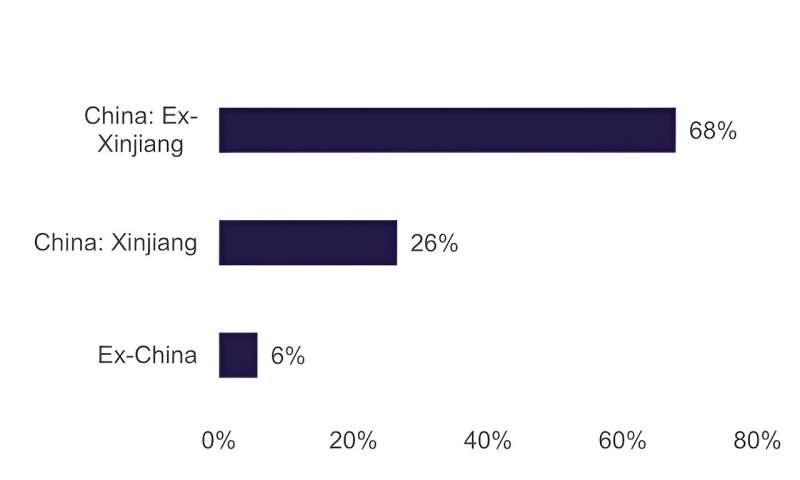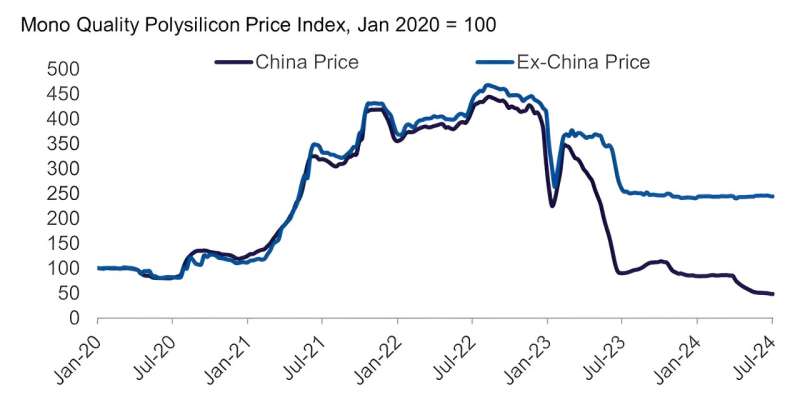This article has been reviewed according to Science X's editorial process and policies. Editors have highlighted the following attributes while ensuring the content's credibility:
fact-checked
trusted source
proofread
Critical mineral power: Australia's silicon future

With the global push towards renewable energy, the role of critical minerals has never been more heightened. Silicon, in the form of quartz, is a fundamental ingredient for solar cells and other key technologies. It's emerging as a linchpin in the quest for a sustainable future.
Yet, the journey from hard rock quartz to solar cell is complex, and Australia's potential to contribute to this journey is still unfolding.
From quartz to solar cell
Solar photovoltaic (PV) technology is set to dominate global energy generation by 2050. However, the current supply chain for solar cells is heavily concentrated in China, posing significant risks related to reliability of supply.
The pathway from quartz to solar cell begins with the extraction of high-quality lump quartz from rock, which is primarily composed of silicon dioxide. The quartz doesn't need to be of very high purity, but it does need to be physically strong enough to cope with the next step, without shattering to dust.
This quartz undergoes a reductive smelting process, where it is heated to extremely high temperatures. A carbon source, often coal or charcoal, reacts with the silicon dioxide, isolating silicon metal and producing carbon dioxide as a byproduct.
The resulting metallurgical-grade silicon has a purity level of about 99.0% to 99.6%. It then needs further chemical purification to create polysilicon with a purity level of 99.9999999% or more.
This highly purified polysilicon is then melted and shaped into cylindrical ingots, which are treated (doped) with boron or phosphorus to change their electrical photovoltaic properties.
These ingots are sliced into thin wafers, about 0.16 mm thick, which serve as the core components of solar cells. The wafers undergo further processing and are assembled into solar cells. These are then soldered together and placed onto a polymer back sheet, coated with specialized glass, and framed by aluminum racks to form complete solar panels or modules.
Australia's unique position to challenges
Australia, with its rich rock quartz deposits and world-class solar resources and solar PV generation potential, is uniquely positioned to develop a domestic silicon production industry.
This move could enhance national energy security, reduce carbon emissions, and create economic opportunities.
Australia also has a competitive advantage because of its potential for low-cost, low-emissions electricity from solar and wind, existing bulk-commodity export infrastructure, and large deposits of high-quality quartz.
However, the challenge for Australia is in establishing polysilicon, ingot and wafer manufacturing—an area where Australia has limited experience. But it is possible to overcome this through partnerships with international technology leaders.
If successful, this would address the most concentrated part of the value chain and create opportunities for both domestic and export markets.
Currently there is only one silicon manufacturing facility in Australia—Simcoa in Western Australia, which is Japanese-owned. It produces 52,000 tons of metallurgical silicon each year, and exports approximately 85% of its total production.
Senior Consultant at global mineral economics firm CRU International, David Royle, said China maintained a global market share of about 94% of polysilicon for use in solar PV cells.
"It would be highly costly for Australia to enter this established market, and the prices for polysilicon, for example, have been historically highly volatile, with a more recent dynamic emerging showing a division of price between China and ex-China material," David said.
"While establishing this industry would be challenging, if we do it right, it could also be really successful and create a sustainable and important domestic industry for Australia. Key to Australia pulling this off is access to stable, cheap energy as well as incentives like the tax credits provided in the Future Made in Australia Act."

The Australian Critical Minerals Research and Development Hub
The Australian Critical Minerals Research and Development Hub, which partners with Geoscience Australia and the Australian Nuclear Science and Technology Organization (ANSTO), is pioneering innovative exploration techniques and fostering industry partnerships to advance the discovery and development of critical minerals in Australia. This includes high-quality quartz deposits.
Critical Mineral R&D Hub Lead for ANSTO, Dr. Chris Griffith, said as part of the Hub's work, ANSTO was leading the investigation of refining technologies for quartz, developing advanced methods that enhance the purity and quality of this critical mineral.
"High temperature chlorination involves exposing an already 'high purity' silica material to chlorine gas at temperatures higher than 1,000°C," Chris said.
"These conditions result in the formation of hydrogen chloride or chloride salts of the key impurity elements, which can be subsequently removed by chlorination or dissolution through leaching.
"However, there aren't many facilities capable of conducting such high temperature chlorination and even fewer dedicated to high purity quartz, so one of our key objectives is to provide such a facility for validation purposes for Australian industry."
A key feature of ANSTO's work on the purification of quartz is the production of materials that could be used to form crucibles for high purity silicon and polysilicon production. Although extremely high purity silicon gets the limelight, very high purity quartz is essential to manufacturing crucibles and containment vessels that do not contaminate the high purity silicon.
Our new report, "From minerals to materials," highlights the research and development needed to fully capitalize on specific critical mineral markets, including silicon. It will inform the Australian Critical Minerals Research and Development Hub.
Lead author of the report, Beni Delaval, said focused research and development (R&D) could help Australia capitalize on its market opportunities by creating new and more efficient pathways that are less costly and more environmentally sustainable.
"When it comes to silicon metal, one of the opportunities highlighted in the report is a less carbon-intensive production process, through the use of biocarbon resources," Beni said.
"There are also other refining practices which have a smaller carbon footprint, which warrant further investigation.
"While there are plenty of opportunities for Australia, getting this industry operational will require strong international collaboration, along with national collaboration between government, industry and the research sector."
The broader opportunity and strategic coordination
David said the silicon metal opportunity for Australia extended beyond solar cells.
"Silicon is also seeing increased use in battery anode chemistries. When blended up to 20% with graphite, it can yield significant energy density improvements and cost reduction," David said.
"CRU estimates that nearly 50% of battery anodes in light-duty battery electric vehicles will contain silicon," David said.
Australia has a golden opportunity to become a global leader in the silicon supply chain, driving the transition to renewable energy and securing economic and environmental benefits. By acting swiftly and strategically, and through coordinated R&D efforts and international and domestic collaboration, Australia can turn its rich mineral endowment into a powerhouse of clean energy, showcasing the true potential of its critical minerals quiet achievers.
More information: Report: From minerals to materials: an assessment of Australia's critical minerals mid-stream processing capabilities


















